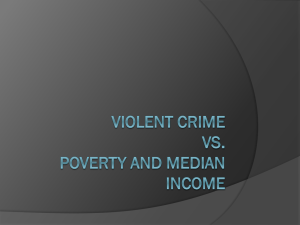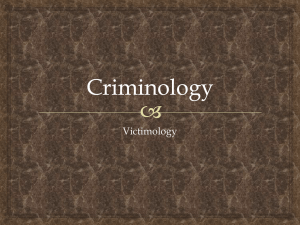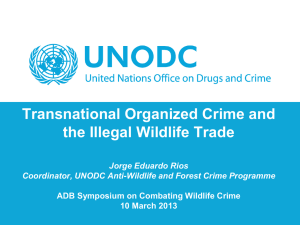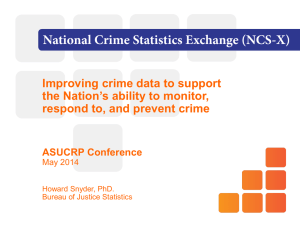Chapter 2a Powerpoint
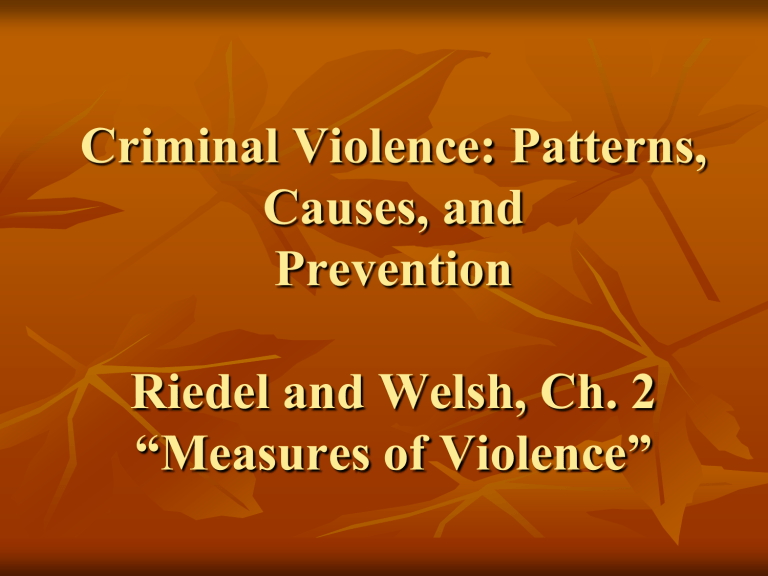
Criminal Violence: Patterns,
Causes, and
Prevention
Riedel and Welsh, Ch. 2
“Measures of Violence”
OUTLINE
Why are measures of crime important?
Crime Rates v. Amounts
Uniform Crime Reports (UCR)
National Incident-Based Reporting System
(NIBRS)
National Crime Victimization Survey (NCVS)
Introduction
We need reliable data about violent crime in order to inform:
(a) public policy
(b) research about violence (e.g., patterns, trends, locations).
Each source of data has certain strengths and limitations. None is perfect.
To be able to use or understand such data, it is necessary to be aware of major strengths and weaknesses.
Why Are Measures of Crime
Important?
1.
2.
3.
Measures are needed to answer important policy questions.
Tripartite perspective: Need measures of crime to assess patterns.
Need to distinguish “opinions” v. “facts” or
“evidence” (social construction)
Example:
Q: Is violent crime going up or down?
A: Answer depends on: 1) the type of measure used, 2) type of crime, 3) time period, 4) rates v. raw numbers.
Crime Rates v. Amounts
The amount is how much violent behavior there is, defined by location and time span.
Crime rates are ratios of amounts to the total population.
1.
2.
3.
4.
5.
Crime rates have five components : amount of the crime population at risk for that crime a constant multiplier such as 100,000 location time span
Crime Rate = (Amount / Population at Risk) ×
100,000
Crime Rates v. Amounts (cont.)
Example: similar amounts of murder, different populations.
There were 510 murders in Chicago and 523 murders in
New York in 2008. Which city had the greatest risk of murder victimization?
If we “plug in” the numbers, we have the following 2008 murder victimization rates:
(New York) 6.26 = (523/ 8,345,075) * 100,000
(Chicago) 18.02= (510/ 2,829,7304) * 100,000
Persons living in Chicago have a risk of being murdered that is almost 3 times higher than the risk for people living in NY.
While the amount of murders for the two cities is similar, the rate of victimization is dramatically different.
Crime Rates & Amounts (cont.)
Example: similar populations, different rates:
There were 23 murders in Austin, Texas, and 234 murders in Baltimore, Maryland, in 2008. Which city had the greatest risk of murder victimization, even though they had similar populations?
If we “plug in” the numbers, we have the following 2008 murder victimization rates:
(Austin) 3.05 = (23/ 753,535) * 100,000
(Baltimore) 36.87= (234/634,549) * 100,000
Persons living in Baltimore have a risk of being murdered that is almost 12 times higher than the risk for people living in Austin.
While the populations for the two cities are similar, the murder victimization rates are dramatically different.
Uniform Crime Reports (UCR)
There are over 17,000 city, county, and state law enforcement agencies reporting to the UCR program directly or through state agencies.
http://www.fbi.gov/ucr/ucr.htm
Part I offenses (“Index” offenses) are divided into crimes against the person (criminal homicide, forcible rape, robbery, aggravated assault, and arson) and crimes against property (burglary, larceny-theft, motor vehicle theft).
Part II offenses include 21 other offenses, such as fraud, embezzlement, weapons offenses, and simple assault.
Uniform Crime Reports (cont.)
1.
While a number of forms are required by the UCR program, three are most relevant to violent crime:
Return A
2.
3.
Age, Sex, Race, and Ethnic Origin of Arrested Offenders
Supplementary Homicide Report
The process of collecting information about violent crime begins with a complaint to law enforcement officials, who investigate and determine whether a criminal offense has occurred (Figure 2.1, p. 28).
Report Directly to UCR
Figure 1
Uniform Crime Reporting Program
Violent
Crime
Police
Department
Police
Records
UCR
Forms
State Uniform
Crime Reporting
Agency
Other
Information
State
Uniform Crime
Reports
Return A -
Crimes Known to the Police
Supplementary
Homicide
Reports (SHR)
Age, Sex, Race,
& Ethnicity of
Arrested Offenders
Uniform Crime
Reporting
Program
Crime in the
United States
National Incident-Based Reporting
System (NIBRS)
The UCR has been subject to criticism from the 1950s onward.
NIBRS was created to address several limitations of the UCR.
http://www.ojp.usdoj.gov/bjs/nibrs.htm
UCR v. NIBRS
UCR NIBRS
DETAIL ON INCIDENTS? NO YES
LINKS VICTIMS W/
OFFENDERS?
HIERARCHY RULE?
NO YES
YES NO
INFORMATION LINKING
INCIDENTS & OFFENDERS?
NO YES
ACCOUNTS FOR OFFENSES
ATTEMPTED V.
COMPLETED?
NO YES
National Crime Victimization Survey
The National Crime Survey began in 1972. In
1991, it was redesigned and retitled the National
Crime Victimization Survey (NCVS).
http://www.ojp.usdoj.gov/bjs/pubalp2.htm#cvus
Crime surveys, unlike information collected from police, rely on interviews with victims.
One purpose of crime surveys is to get an idea of how much crime occurs that is not reported to or
by the police.
Crime rates estimated by the UCR are only about one half to one third of those based on victim reports.
NCVS (cont.)
How are Incidents Collected?
The NCVS collects victimization data from a nationally representative sample of about 100,000 individuals age 12 or older living in about 50,000 U.S. households. Interviews are translated for non-English-speaking respondents. The interview takes about ½ hour.
What is Collected?
There are two steps in interviewing victims:
1.
2.
Screening questions are asked to determine whether the respondent has been the victim of a crime in the past 4 months.
If the respondent says that someone in the household has been a victim, then an individual victimization report is completed for each incident mentioned in response to the screening questions.
NCVS (cont.)
In addition to estimating the number of victimizations, the
NCVS gathers details on each incident:
Characteristics of the victim (age, sex, race, ethnicity, marital status, income, and educational level)
Characteristics of the offender (sex, race, and approximate age)
Relationship between victim and offender
Month, time, and location of the crime
Self-protective actions taken by the victim during an incident and results of those actions
Consequences of the victimization, including any injury or property loss
Whether the crime was reported to police; reasons for reporting/not reporting
Offender use of weapons, drugs, and alcohol
Limitations of the NCVS
Cost of Large Samples . To get reliable estimates, a very large number of people must be sampled.
Poor Memory and Telescoping . The longer the time between the actual victimization and the interview, the greater the likelihood of memory failure. There is a danger of telescoping: a victimization that occurred outside the requested time span is mistakenly recalled as occurring within the last 6 months.
Errors in Reporting
Mistaken reporting : respondent believes he or she was the victim of a crime but was not.
Sampling bias: Potential undercounting of young people, males, and members of minority groups



